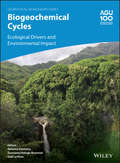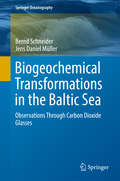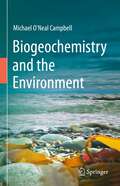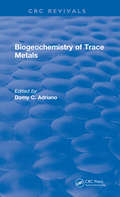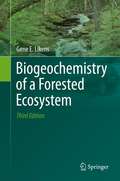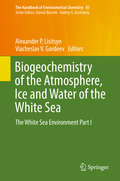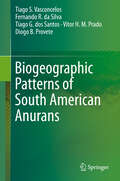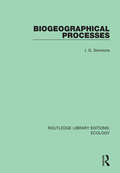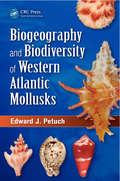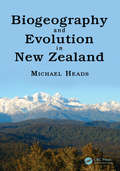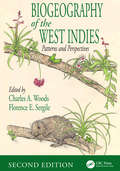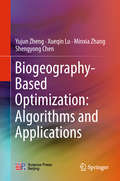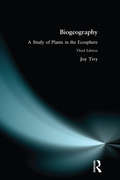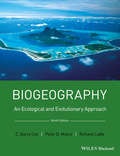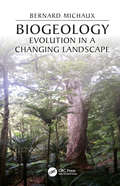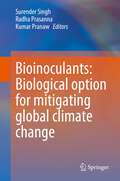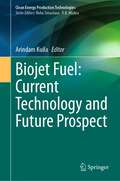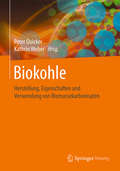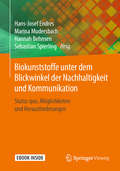- Table View
- List View
Biogeochemical Cycle of Mercury in Reservoir Systems in Wujiang River Basin, Southwest China
by Xinbin Feng Bo Meng Haiyu Yan Xuewu Fu Heng Yao Lihai ShangThis book presents an intensive study on the biogeochemical cycle of mercury in a river-reservoir system in Wujiang River Basin, the upper branch of the Yangtze River. Six reservoirs located in the mainstream of the Wujiang River and their corresponding inflow/outflow rivers were selected for inclusion in this study, which was conducted by researchers from the Institute of Geochemistry, Chinese Academy of Sciences. The concentration and distribution of Hg in reservoirs (the water column, sediment, sediment pore water), inflow/outflow rivers of reservoirs, and wet deposition in Wujiang River Basin were systematically investigated, and measurements were taken of the water/air exchange flux of gaseous elemental mercury (GEM). On the basis of the data gathered, a detailed mass balance of total mercury (THg) and methylmercury (MeHg) in the six reservoirs was developed. In addition, the book identifies the primary factors controlling Hg methylation in the river-reservoir system in Wujiang River Basin. The accumulation and bio-magnification of Hg species within food chains in reservoirs and human health risk of MeHg exposure through fish consumption are also included in this book.
Biogeochemical Cycles: Ecological Drivers and Environmental Impact (Geophysical Monograph Series #248)
by Katerina Dontsova Zsuzsanna Balogh-Brunstad Gaël Le RouxBiogeochemical Cycles: Ecological Drivers and Environmental Impact is a collection of the latest information on the techniques and methods currently used in this field, focusing on biological and/or ecological effects of biogeochemical elemental cycles including carbon, nitrogen, major and trace elements, chemical weathering on multiple scales of nanometers to watersheds, and advances in technology of studying these processes.Volume highlights include:- Remote sensing and modeling techniques used to quantify changes in the ecosystem/s productivity, and microscopic techniques to estimate the extent of weathering - Novel isotopic techniques to assess changes in trace elemental cycles as influenced by the changing climate, and plant-mediated effect of climate change on major elemental cycles - Impact of climate change and other anthropogenic influences in agricultural and extreme (frontier) environmentsBiogeochemical Cycles: Ecological Drivers and Environmental Impact is a valuable resource for students, researchers and professionals in the field of biogeosciences, hydrology, ecology, earth and planetary surface processes, volcanology, petrology, geochemistry, mineralogy, soil science, agricultural science, climate change and environmental science.
Biogeochemical Transformations in the Baltic Sea: Observations Through Carbon Dioxide Glasses (Springer Oceanography)
by Bernd Schneider Jens Daniel MüllerThis book provides a comprehensive review of the biogeochemistry in the Baltic Sea. It is based on the fact that biogeochemical processes that are relevant for the ecological state of the Baltic Sea (and other sea areas), are all in some way related to the production and mineralization of organic matter (biomass) and thus are associated with the consumption or release of CO2. The significant progress with regard to our chemical analytical capabilities concerning the marine CO2 system has facilitated new approaches to study the Baltic Sea biogeochemistry, in particular with regard to a quantitative process understanding. To demonstrate this, the authors present the fundamentals of the marine CO2 system in a theoretically sound, but still intelligible way. This is followed by a comprehensive presentation of our current knowledge about the CO2 system in the Baltic Sea and the implications for our understanding of biogeochemical processes such as production/mineralization of organic matter and the stoichiometry involved, nitrogen fixation, denitrification, and phosphate transformations at varying redox conditions. Finally, the CO2 gas exchange balance and related problems such as acidification are addressed.
Biogeochemistry and the Environment
by Michael O'Neal CampbellBiogeochemistry may be defined as the science that combines biological and chemical perspectives for the examination of the Earth’s surface, including the relations between the biosphere, lithosphere, atmosphere, and hydrosphere. Biogeochemistry is a comparatively recently developed science, that incorporates scientific knowledge and findings, research methodologies, and models linking the biological, chemical, and earth sciences. Therefore, while it is a definitive science with a strong theoretical core, it is also dynamically and broadly interlinked with other sciences. This book examines the complex science of biogeochemistry from a novel perspective, examining its comparatively recent development, while also emphasizing its interlinked relationship with the earth sciences (including the complementary science of geochemistry), the geographical sciences (biogeography, oceanography, geomatics, earth systems science), the biological sciences (ecology, wildlife studies, biological aspects of environmental sciences) and the chemical sciences (including environmental chemistry and pollution). The book covers cutting-edge topics on the science of biogeochemistry, examining its development, structure, interdisciplinary, multidisciplinary, and transdisciplinary relations, and the future of the current complex knowledge systems, especially in the context of technological, developments, and the computer and data fields.
Biogeochemistry of Trace Metals: Advances In Trace Substances Research (CRC Press Revivals)
by Domy C. AdrianoBiogeochemistry of Trace Metals is a compendium of the most recent information available on the effects of trace metals in soil quality and its potential threat on the transfer of these contaminants to consumers. Most of the chapters in the book were presented as papers during the First International Conference on the Biogeochemistry of Trace Elements (formerly Metals in Soils, Plants, Waters, and Animals) held in Orlando, Florida in May, 1990. Topics discussed include background levels of metals in soils and/or plants (covering western Europe; temperate, humid Europe; and the People's Republic of China); metal cycling and transfer in the food chain in agroecosystems; uptake and accumulation of metals by bacteria, fungi, and invertebrates; mechanistic aspects of metals; the microbial aspects of soil selenium losses; and manganese sorption on soil constituents.
Biogeochemistry of a Forested Ecosystem
by Gene E. LikensThe goal of this Third Edition is to update long-term data presented in earlier editions and to generate new syntheses and conclusions about the biogeochemistry of the Hubbard Brook Valley based on these longer-term data. There have been many changes, revelations, and exciting new insights generated from the longer data records. For example, the impact of acid rain peaked during the period of the HBES and is now declining. The longer-term data also posed challenges in that very marked changes in fluxes occurred in some components, such as hydrogen ion and sulfate deposition, calcium and nitrate export in stream water and biomass accumulation, during the almost 50 years of record. Thus, presenting "mean" or "average" conditions for many components for such a long period, when change was so prominent, do not make sense. In some cases, pentads or decades of time are compared to show these changes in a more smoothed and rational way for this long period. In some cases, a single period, often during periods of rapid change, such as acidification, is used to illustrate the main point(s). And, for some elements a unique mass balance approach, allowing the calculation of the Net Ecosystem Flux (NEF), is shown on an annual basis throughout the study.
Biogeochemistry of the Atmosphere, Ice and Water of the White Sea: The White Sea Environment Part I (The Handbook of Environmental Chemistry #81)
by Alexander P. Lisitsyn Viacheslav V. GordeevThis book is devoted to the biogeochemical environment of the White Sea, an inland sea in the Northwestern region of Russia. It provides a comprehensive review and discusses the latest research findings on the oceanology, sedimentology and biogeochemistry of the White Sea water column. The topics discussed include the regulation of the physico-geographical conditions in the White Sea basin; dispersed sedimentary substance of the atmosphere and the cryosphere; the geochemical peculiarities of the river discharge into the White Sea; and the phyto- and zooplankton activities in the White Sea. Taking the biggest river in the White Sea basin as an example, the authors closely examine the deposition of suspended particulate matter, the biogeochemical behaviour of dissolved and suspended forms of organic material and the significant group of chemical elements in the river-sea mixing zone of the Severnaya Dvina River. The book ends with a summary of the key conclusions and recommendations. Together with the companion volume Sedimentation Processes in the White Sea: The White Sea Environment Part II, it offers an essential source of information for postgraduate students, researchers and stakeholders alike.
Biogeochemistry of the Critical Zone (Advances in Critical Zone Science)
by William H. McDowell Adam S. Wymore Wendy H. Yang Whendee L. Silver Jon ChoroverThis book highlights recent advances in the discipline of biogeochemistry that have directly resulted from the development of critical zone (CZ) science. The earth's critical zone (CZ) is defined from the weathering front and lowest extent of freely circulating groundwater up through the regolith and to the top of the vegetative canopy. The structure and function of the CZ is shaped through tectonic, lithologic, hydrologic, climatic, and biological processes and is the result of processes occurring at multiple time scales from eons to seconds. The CZ is an open system in which energy and matter are both transported and transformed. Critical zone science provides a novel and unifying framework to consider those coupled interactions that control biogeochemical cycles and fluxes of energy and matter that are critical to sustaining a habitable planet. Biogeochemical processes are at the heart of energy and matter fluxes through ecosystems and watersheds. They control the quantity and quality of carbon and nutrients available for living organisms, control the retention and export of nutrients affecting water quality and soil fertility, and influence the ability for ecosystems to sequester carbon. As the term implies, biogeochemical cycles, and the rates at which they occur, result from the interaction of biological, chemical, and physical processes. However, finding a unifying framework by which to study these interactions is challenging, and the different components of bio-geo-chemistry are often studied in isolation. The authors provide both reviews and original research contributions with the requirement that the chapters incorporate a CZ framework to test biogeochemical theory and/or develop new and robust predictive models regarding elemental cycles. The book demonstrates how the CZ framework provides novel insights into biogeochemistry.
Biogeographic Patterns of South American Anurans
by Tiago S. Vasconcelos Fernando R. da Silva Tiago G. dos Santos Vitor H. Prado Diogo B. ProveteThis book analyzes different facets of anuran amphibian distribution in South America. We integrate alternative biological metrics employing cutting-edge methods to understand the dynamic processes underlying species distribution patterns. By using the modern biogeographic toolbox, we explore how richness gradients, phylogenetic diversity, functional diversity, and range size/endemism distribution of amphibians vary along the continent. Moreover, we present a robust proposal for priority areas for conservation of anurans in South America that maximizes representativeness of distinct biodiversity facets.
Biogeographical Processes (Routledge Library Editions: Ecology #11)
by I. G. SimmonsOriginally published in 1982, Biogeographical Processes is a concise introduction to biogeography aimed at undergraduate students. It provides a detailed overview of man and his environment and includes data from such research projects as that of the International Biological Programme. The book argues that natural processes can be viewed as a datum line to which the human impact through time is added. It suggests that through this datum line, the man and the biological environment are inextricably linked. The book firstly examines the fundamental processes determining the distribution of plants and animals, and the interactions between such processes leading to the concept of the ecosystem. The book also examines major world ecosystems, or biomes, such as forests, grasslands and oceans as if they were in a natural condition and discusses the affect of human impact upon such systems. The book also discusses the alternative future relationships of man and other living organisms. Although over 30 years old, the book still contains a useful and detailed overview of biogeography. It will be of interest to students or lecturers in ecology, biology and the environmental sciences.
Biogeography and Biodiversity of Western Atlantic Mollusks
by Edward J. PetuchShallow water marine molluscan faunas are distributed in a pattern of distinct, geographically definable areas. This makes mollusks ideal for studying the distribution of organisms in the marine environment and the processes and patterns that control their evolution. Biogeography and Biodiversity of Western Atlantic Mollusks is the first book to us
Biogeography and Evolution in New Zealand (CRC Biogeography Series #1)
by Michael HeadsBiogeography and Evolution in New Zealand provides the first in-depth treatment of the biogeography of New Zealand, a region that has been a place of long-enduring interest to ecologists, evolutionary scientists, geographers, geologists, and scientists in related disciplines. It serves as a key addition to the contemporary discussion on regionalization—how is New Zealand different from the rest of the world? With what other areas does it share its geology, history, and biota? Do new molecular phylogenies show that New Zealand may be seen as a biological ‘parallel universe’ within global evolution?
Biogeography of Australasia
by Michael HeadsOver the last decade, molecular studies carried out on the Australasian biota have revealed a new world of organic structure that exists from submicroscopic to continental scale. Furthermore, in studies of global biogeography and evolution, DNA sequencing has shown that many large groups, such as flowering plants, passerine birds and squamates, have their basal components in this area. Using examples ranging from kangaroos and platypuses to kiwis and birds of paradise, the book examines the patterns of distribution and evolution of Australasian biodiversity and explains them with reference to tectonic and climatic change in the region. The surprising results from molecular biogeography demonstrate that an understanding of evolution in Australasia is essential for understanding the development of modern life on Earth. A milestone in the literature on this subject, this book will be a valuable source of reference for students and researchers in biogeography, biodiversity, ecology and conservation.
Biogeography of the West Indies: Patterns and Perspectives, Second Edition
by Charles A. Woods Florence E. SergileAs a review of the status of biogeography in the West Indies in the 1980s, the first edition of Biogeography of the West Indies: Past, Present, and Future provided a synthesis of our current knowledge of the systematics and distribution of major plant and animal groups in the Caribbean basin. The totally new and revised Second Edition, Biogeography
Biogeography-Based Optimization: Algorithms and Applications
by Yujun Zheng Xueqin Lu Minxia Zhang Shengyong ChenThis book introduces readers to the background, general framework, main operators, and other basic characteristics of biogeography-based optimization (BBO), which is an emerging branch of bio-inspired computation. In particular, the book presents the authors’ recent work on improved variants of BBO, hybridization of BBO with other algorithms, and the application of BBO to a variety of domains including transportation, image processing, and neural network learning. The content will help to advance research into and application of not only BBO but also the whole field of bio-inspired computation. The algorithms and applications are organized in a step-by-step manner and clearly described with the help of pseudo-codes and flowcharts. The readers will learn not only the basic concepts of BBO but also how to apply and adapt the algorithms to the engineering optimization problems they actually encounter.
Biogeography: A Study of Plants in the Ecosphere
by Joy TivyThe third edition of this classic text, presents a broad-based study of the variations in the form and functioning of the biosphere at regional and global scale.
Biogeography: An Ecological and Evolutionary Approach
by Barry Cox Peter D. MooreThrough eight successful editions, and over nearly 40 years, Biogeography: An Ecological and Evolutionary Approach has provided a thorough and comprehensive exploration of the varied scientific disciplines and research that are essential to understanding the subject. The text has been praised for its solid background in historical biogeography and basic biology, that is enhanced and illuminated by discussions of current research.This new edition incorporates the exciting changes of the recent years, and presents a thoughtful exploration of the research and controversies that have transformed our understanding of the biogeography of the world. It also clearly identifies the three quite different arenas of biogeographical research: continental biogeography, island biogeography and marine biogeography. It is the only current textbook with full coverage of marine biogeography. It reveals how the patterns of life that we see today have been created by the two great Engines of the Planet - the Geological Engine, plate tectonics, which alters the conditions of life on the planet, and the Biological Engine, evolution, which responds to these changes by creating new forms and patterns of life.
Biogeography: An Integrative Approach of the Evolution of Living
by Eric GuilbertThe recent progress in analytical methods, aided by bringing in a wide range of other disciplines, opens up the study to a broader field, which means that biogeography now goes far beyond a simple description of the distribution of living species on Earth.Originating with Alexander von Humboldt, biogeography is a discipline in which ecologists and evolutionists aim to understand the way that living species are organized in connection with their environments. Today, as we face major challenges such as global warming, massive species extinction and devastating pandemics, biogeography offers hypotheses and explanations that may help to provide solutions.This book presents as wide an overview as possible of the different fields that biogeography interacts with. Sixteen authors from all over the world offer different approaches based on their specific areas of knowledge and experience; thus, we intend to illustrate the vast number of diverse aspects covered by biogeography.
Biogeography: Biological Diversity across Space and Time
by Robert J. Whittaker Mark V. Lomolino Brett R. RiddleBiogeography, Fifth Edition, is written as a primary text for undergraduate and graduate courses, and is also an invaluable reference for biogeographers, ecologists, evolutionary biologists, and conservation biologists. Its fundamental assertion is that patterns in biological diversity make little sense unless viewed within an explicit geographic context. Starting from principal patterns and fundamental principles, and assuming only a rudimentary knowledge of biology, geography, and Earth history, the text explains the relationships between geographic variation in biological diversity and the geological, ecological, and evolutionary processes that have produced them.
Biogeography: Introduction to Space, Time, and Life
by Glen M. MacDonaldIntroduce students to the diversity embraced by the discipline of biogeography, revised and updated throughout Biogeography: Space, Time and Life provides a comprehensive introduction to the study of large-scale geographic distributions of life, focusing on ecology, evolution, physical geography and conservation. Now in its second edition, this award-winning textbook illustrates key concepts in biogeography using engaging empirical examples of modern plant and animal distributions, long-term evolutionary history and current conservation challenges. With an accessible style and clear structure, Biogeography defines fundamental terms from biology and physical geography, describes ecological biogeography and the biological features of the physical environment, explains key concepts in historical biogeography, explores the Earth’s diverse biogeographic subdivisions, current issues in conservation and more. Student-friendly chapters cover topics including biological interactions, speciation and extinction, changing continents and climates, human evolution, modern biodiversity, the relationship between humans and plants, animals and other organisms, and the role of biogeography in conservation. Introduces basic concepts in the study of animal and vegetation distributions, including various human and environmental impacts on these distributions Examines how biological factors such as heat and predation impact different species of plants and animals Features short biographical sketches of major figures in the field and examples of the natural histories of various species Considers the application of biogeographic theory and techniques for the benefit of conservation and sustainability Includes a companion website for students, as well as an instructor’s site with supplementary teaching resourcesDesigned for students across a wide range of disciplines, from the biological and physical sciences to the social sciences and humanities, Biogeography: Space, Time and Life, Second Edition is an excellent textbook for undergraduate courses in biogeography, Earth systems science, and environmental studies.
Biogeology: Evolution in a Changing Landscape (CRC Biogeography Series)
by Bernard MichauxThis detailed exposition gives background and context to how modern biogeography has got to where it is now. For biogeographers and other researchers interested in biodiversity and the evolution of life on islands, Biogeology: Evolution in a Changing Landscape provides an overview of a large swathe of the globe encompassing Wallacea and the western Pacific. The book contains the full text of the original article explored in each chapter, presented as it appeared on publication. Key features: Holistic treatment, collecting together a series of important biogeographical papers into a single volume Authored by an expert who has spent nearly three decades actively involved in biogeography Describes and interprets a region of exceptional biodiversity and extreme endemism The only book to provide an integrated treatment of Wallacea, Melanesia, New Zealand, the New Zealand Subantarctic Islands and Antarctica Offers a critique of fashionable neo-dispersalist arguments, showing how these still suffer from the same weaknesses of the original Darwinian formulation. The chapters also include analysis of many major theoretical and philosophical issues of modern biogeographic theory, so that those interested in a more philosophical approach will find the book stimulating and thought-provoking.
Bioinoculants: Biological Option for Mitigating global Climate Change
by Surender Singh Radha Prasanna Kumar PranawThis edited book covers various bioinoculants for sustainable crop production under the changing global climate. The book envisages a compilation of articles relevant to the current status of production and use of novel microbial inoculants for different crops and highlights their role in mitigating global climate challenges. These include nutrient deficiencies, salinity, drought, and emerging pathogens. In addition, success stories and commercialization aspects are also discussed. Growing environmental concerns related to climate change can potentially decrease the global yield capacity of agricultural systems. Agricultural productivity is severely affected by major biotic and abiotic factors. The phytomicrobiome plays a critical role in the survival of the holobiont, particularly for plants growing in extreme environments. The use of microbial-based agricultural inputs has a long history, beginning with a broad-scale rhizobial inoculation of legumes in the early twentieth century. Microbial inoculants are considered one of the best and most effective strategies for sustainable agriculture under climate change, and a viable solution to meet the twin challenges of global food security and environmental sustainability. It is therefore imperative to understand the current status and development in the area of bioinoculants from a global perspective. The chapter’s focus would be on major agro-ecologies, covering all major crops across the globe, along with the commercialization status of different bioinoculants in different countries The book caters to the needs of the students, faculty, policymakers, and researchers working in the area of microbiology, biotechnology, environmental sciences, and botany.
Biojet Fuel: Current Technology and Future Prospect (Clean Energy Production Technologies)
by Arindam KuilaThis book covers the basic knowledge of biojet fuel, explores the current technological status, and presents future prospects for commercial biojet fuel production. The focus of this book is on biojet fuel production from different types of potential substrates. It also includes technoeconomic analysis and life cycle assessment of biojet fuel. Biojet fuel is currently recognized as the best alternative to petroleum-based jet fuel due to its renewability and sustainable features. However, there is a scarcity of reports on biojet fuel production from various types of substrates.The aviation industry globally consumes approximately 200 million tonnes of jet fuels each year, with a projected continuous growth rate of 5% per year until 2050 (Seymour et al., 2020). Currently, the global demand for jet fuel is predominantly met by petroleum-based fuels. However, the limited availability of fossil fuels and increasing concerns about climate change have placed significant pressure on commercial airlines to reduce greenhouse gas emissions and embrace cleaner and more sustainable practices.Biojet fuel has emerged as the most favorable alternative to petroleum-based jet fuel due to its renewable nature and sustainable characteristics. Despite its potential, there is a limited number of reports available on the production of biojet fuel from different types of substrates. The present scenario of biojet fuel necessitates the development of improved and cost-effective technologies that can yield long-term benefits.The book is useful for students and researchers in various branches of life sciences, including environmental biotechnology, bioprocess engineering, renewable energy, chemical engineering, nanotechnology, biotechnology, microbiology, and more.
Biokohle: Herstellung, Eigenschaften und Verwendung von Biomassekarbonisaten
by Andrea Kruse Peter Quicker Kathrin Weber Dennis Blöhse Thomas Echterhof Sabrina Eichenauer Simone Heger Claudia Kammann Marc-André Schulten Christoph Sager Saulo Seabra Klaus Serfass Ernst StadlbauerBiomassekarbonisate (Biokohlen) besitzen signifikant unterschiedliche Eigenschaften, die von den Herstellungsverfahren, Prozessbedingungen und Ausgangssubstraten abhängen. Im Buch sind die technisch verfügbaren Verfahren zur Erzeugung von Biokohle beschrieben und die thermochemischen Prozesse erörtert. Anhand von zahlreichen farbigen Abbildungen sind die Prozesse, Eigenschaften und Einsatzmöglichkeiten veranschaulicht. Der Fokus des Buches liegt auf den großtechnischen Anwendungen als Energieträger, als Reduktions- oder Aufkohlungsmittel in metallurgischen Verfahren, in Recyclingprozessen oder in Kraft- und Zementwerken. Aber auch die Anwendung von Biomassekarbonisaten in der Landwirtschaft als Bodenhilfsstoff oder in der Tierhaltung ist aufgezeigt.
Biokunststoffe unter dem Blickwinkel der Nachhaltigkeit und Kommunikation: Status quo, Möglichkeiten und Herausforderungen
by Hans-Josef Endres Marina Mudersbach Hannah Behnsen Sebastian SpierlingDas Buch zeigt, wie eine Nachhaltigkeitsbewertung von Biokunststoffen gelingen kann und wie die Ergebnisse einer solchen Bewertung ausfallen. Es analysiert die öffentliche Wahrnehmung beim Verbraucher sowie die politischen Rahmenbedingungen von Biokunststoffen.

